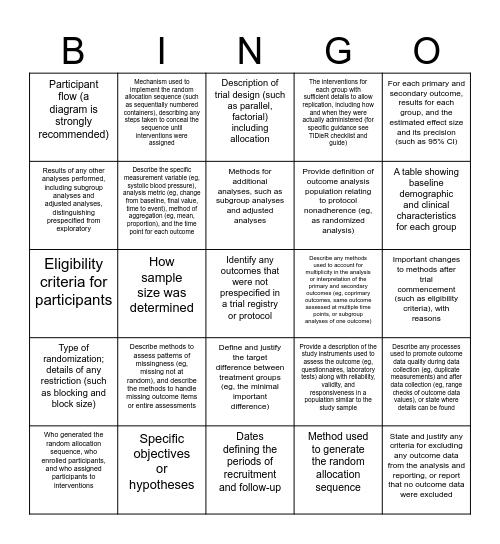

This bingo card has 30 words: Specific objectives or hypotheses, Provide a rationale for the selection of the domain for the trial’s primary outcome, How sample size was determined, Statistical methods used to compare groups for primary and secondary outcomes, Participant flow (a diagram is strongly recommended), Description of trial design (such as parallel, factorial) including allocation, Describe the specific measurement variable (eg, systolic blood pressure), analysis metric (eg, change from baseline, final value, time to event), method of aggregation (eg, mean, proportion), and the time point for each outcome, Define and justify the target difference between treatment groups (eg, the minimal important difference), Describe any methods used to account for multiplicity in the analysis or interpretation of the primary and secondary outcomes (eg, coprimary outcomes, same outcome assessed at multiple time points, or subgroup analyses of one outcome), Dates defining the periods of recruitment and follow-up, Important changes to methods after trial commencement (such as eligibility criteria), with reasons, Identify any outcomes that were not prespecified in a trial registry or protocol, Method used to generate the random allocation sequence, State and justify any criteria for excluding any outcome data from the analysis and reporting, or report that no outcome data were excluded, A table showing baseline demographic and clinical characteristics for each group, Settings and locations where the data were collected, Provide a description of the study instruments used to assess the outcome (eg, questionnaires, laboratory tests) along with reliability, validity, and responsiveness in a population similar to the study sample, Type of randomization; details of any restriction (such as blocking and block size), Describe methods to assess patterns of missingness (eg, missing not at random), and describe the methods to handle missing outcome items or entire assessments, For each primary and secondary outcome, results for each group, and the estimated effect size and its precision (such as 95% CI), Eligibility criteria for participants, Describe who assessed the outcome (eg, nurse, parent), and any qualifications or trial-specific training necessary to administer the study instruments to assess the outcome, Mechanism used to implement the random allocation sequence (such as sequentially numbered containers), describing any steps taken to conceal the sequence until interventions were assigned, Provide definition of outcome analysis population relating to protocol nonadherence (eg, as randomized analysis), Results of any other analyses performed, including subgroup analyses and adjusted analyses, distinguishing prespecified from exploratory, The interventions for each group with sufficient details to allow replication, including how and when they were actually administered (for specific guidance see TIDieR checklist and guide), Describe any processes used to promote outcome data quality during data collection (eg, duplicate measurements) and after data collection (eg, range checks of outcome data values), or state where details can be found, Who generated the random allocation sequence, who enrolled participants, and who assigned participants to interventions, Methods for additional analyses, such as subgroup analyses and adjusted analyses and All important harms or unintended effects in each group.
Data Explorer BINGO | Psychology Research Methods | YELP Data Literacy (FPA 2022) | Psychology Research Methods | Psychology Research Methods
Share this URL with your players:
For more control of your online game, create a clone of this card first.
Learn how to conduct a bingo game.
With players vying for a you'll have to call about __ items before someone wins. There's a __% chance that a lucky player would win after calling __ items.
Tip: If you want your game to last longer (on average), add more unique words/images to it.